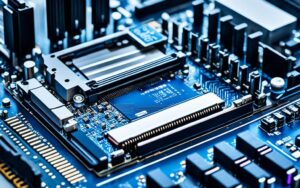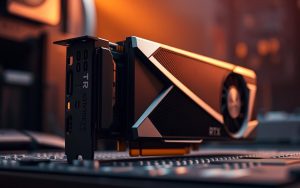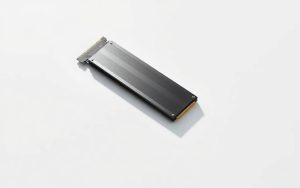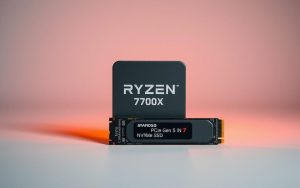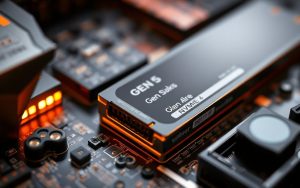Table of Contents
The latest PCIe 5.0 SSDs, also known as Gen5 NVMe drives, bring blazing-fast speeds ideal for gamers and content creators. But many users wonder if these cutting-edge storage solutions function in older motherboard slots designed for Gen3 or Gen4.
Understanding compatibility matters when upgrading systems. While newer drives often fit physically, performance may drop in older slots. Manufacturers like Crucial confirm their T700/T705 models support backward operation, but with reduced bandwidth.
Before purchasing, always check your motherboard specifications. This guide explains real-world implications, helping you make informed decisions about SSD upgrades without costly mistakes.
Understanding Gen 5 NVMe and PCIe Backward Compatibility
Modern storage solutions rely on advanced hardware and software layers working together. The combination of PCIe 5.0 and NVMe protocol creates a powerful interface for high-speed data transfer. But how do these technologies interact with older systems?
What Is PCIe 5.0 and How Does It Differ from Older Generations?
PCIe standards evolve to meet growing bandwidth demands. The latest version doubles the transfer rate compared to its predecessor:
- Gen3: 8 GT/s (~4GB/s per lane)
- Gen4: 16 GT/s (~8GB/s per lane)
- PCIe 5.0: 32 GT/s (~16GB/s per lane)
This leap enables SSD manufacturers like Crucial to develop drives with unprecedented speeds. Their 232-Layer 3D NAND technology fully utilizes this potential.
NVMe Protocol: The Software Layer of SSD Compatibility
While PCIe handles physical connections, NVMe manages data flow. This protocol operates independently across generations:
- Optimizes command queues for efficient processing
- Prioritizes critical operations automatically
- Works universally with all PCIe versions
Major brands including Phison, AMD, and Intel collaborate to ensure broad ecosystem support. For detailed compatibility checks, consult motherboard specifications before upgrading.
Is Gen 5 NVMe Backwards Compatible? The Short Answer
Cutting-edge SSDs promise impressive speeds, but will they work in your current setup? The answer involves both physical connections and system capabilities.
Physical Connections: Universal M.2 Design
All modern M.2 drives share identical physical connectors. This standardization means newer models physically fit older motherboard slots. The 2280 form factor (22mm wide, 80mm long) remains consistent across generations.

However, some hardware limitations exist. Older computers might have M.2 slots supporting only SATA drives rather than PCIe. Always verify your specific slot type before purchasing.
Automatic System Recognition
Modern operating systems handle new drives seamlessly. Windows 10/11 and Linux distributions automatically detect storage devices. Drivers adjust performance based on available PCIe 4.0 or earlier standards.
UEFI firmware enhances this compatibility. Systems using legacy BIOS might require updates. “We recommend checking for firmware updates before installing new storage,” advises Crucial’s technical team.
Performance scales automatically too. A SSD designed for PCIe 5.0 will operate at PCIe 3.0 speeds if that’s all the slot supports. No manual configuration is needed.
Important Considerations
- Thermal management: Newer drives run hotter. Ensure proper cooling in older systems
- Lane configurations: Some motherboards offer only x2 lanes instead of x4
- Tool verification: Use Crucial’s System Scanner for instant compatibility checks
While physically compatible, optimal performance requires matching your computer capabilities with the right storage solution.
Performance Trade-Offs When Using Gen 5 NVMe in Older Slots
Gamers and creators often face trade-offs when using cutting-edge SSDs in legacy systems. While these drives deliver groundbreaking speeds, older PCIe 4.0 or Gen3 slots can bottleneck their potential.
Bandwidth Limitations: Gen 4 vs. Gen 5 Speeds
Theoretical bandwidth drops significantly in older slots. A PCIe 5.0 drive like the Crucial T700 reaches 14,500MB/s read speeds in ideal conditions. In a Gen4 slot, this halves to ~7,000MB/s.
| Scenario | Sequential Read Speed | Random 4K Q1T1 |
|---|---|---|
| Gen5 Slot | 14,500MB/s | 1,500K IOPS |
| Gen4 Slot | 7,000MB/s | 1,450K IOPS |
| Gen3 Slot | 3,500MB/s | 1,400K IOPS |
Random data operations (like OS responsiveness) show minimal differences. Sustained workloads, however, suffer. “8K RAW video editing sees 30% longer render times on Gen3,” notes a Crucial benchmark.
Real-World Impact on Gaming and Content Creation
For gaming, load time differences are marginal—often under 1 second. DirectStorage API benefits require PCIe 4.0 or newer. Thermal throttling risks rise in cramped older systems during extended sessions.
- 4K editing: Projects with large assets benefit from full bandwidth.
- Thermal limits: Gen5 drives run hotter; ensure adequate cooling.
- Cost-value: Gen4 may suffice for most users.
How to Check Your System’s Compatibility
Before upgrading your storage, verifying your computer specifications ensures smooth performance. Modern SSDs offer impressive speeds, but your motherboard must support their full potential. Follow these steps to confirm compatibility and avoid bottlenecks.

Identifying Your Motherboard’s PCIe Generation
Start by locating your motherboard model. Windows users can press Windows + R, type msinfo32, and check the “BaseBoard Product” field. Alternatively, use Command Prompt with wmic baseboard get product,Manufacturer.
Third-party tools like CPU-Z provide detailed hardware insights. Navigate to the “Mainboard” tab to view your PCIe version. Most manufacturers list slot specifications in their manuals or support sites.
Tools to Verify SSD and Slot Compatibility
Automated solutions simplify the process. Crucial’s System Scanner analyzes your setup and recommends suitable upgrades. For advanced users, HWInfo displays real-time interface details, including lane configurations.
Manual checks remain valuable for troubleshooting. Open your case and inspect M.2 slots—look for labels like “PCIe 3.0 x4” or “SATA.” Some boards mix slot types, so verify each one individually.
- BIOS checks: Enter UEFI settings (usually Del/F2) and locate PCIe configuration menus
- Chipset limitations: Some slots connect through the chipset, reducing bandwidth
- CPU support: Ryzen 7000 and Intel Raptor Lake CPUs fully enable PCIe 5.0
Always cross-reference your findings with manufacturer documentation. This prevents mismatches between your SSD and available slots.
Motherboards That Support Gen 5 NVMe (2024 Update)
Building a high-performance system starts with the right foundation. The latest platforms from Intel and AMD unlock full potential for cutting-edge storage solutions. These motherboards deliver the necessary hardware support for blistering-fast SSDs.

When selecting a board, consider thermal solutions and lane allocation. Premium models often include reinforced M.2 slots with heatsinks. Some share bandwidth between slots, affecting multiple drive setups.
Top Intel-Compatible Options
Intel’s Z790 chipset leads the pack for LGA1700 systems. The ASUS ROG MAXIMUS Z790 APEX ENCORE stands out with dual PCIe 4.0 x16 slots and five M.2 connectors. Its stacked heatsink design maintains optimal temperatures during sustained loads.
GIGABYTE’s Z790 AORUS MASTER offers excellent value. This board features:
- Quad M.2 slots (one Gen5, three Gen4)
- 10GbE LAN + WiFi 6E
- Direct 20+1+2 phase power delivery
Best AMD Ryzen Platforms
For AMD Ryzen 7000 series builders, the MSI MEG X670E GODLIKE dominates. Its PCIe 5.0 lanes extend to both storage and graphics cards. The board includes a dynamic cooling system with touchscreen monitoring.
ASRock’s X670E Taichi Carrara balances features and affordability. Key specs include:
- Three Gen5 M.2 slots
- Dual Thunderbolt 4 ports
- Pre-installed I/O shield for easy installation
Early adopters should check for BIOS updates. Some boards require firmware flashes to stabilize Gen5 SSDs. Manufacturers continue refining compatibility through regular updates.
Who Should Upgrade to Gen 5 NVMe?
High-performance computing demands the right storage solution. While PCIe 5.0 SSDs deliver groundbreaking speed, their value depends on specific workloads. This breakdown helps identify ideal adopters and smarter alternatives.

Ideal Use Cases: Gamers, Creators, and Professionals
Content creators working with 8K footage gain tangible benefits. Crucial’s 232-Layer NAND technology slashes render time by 40% in Adobe Premiere compared to Gen4. Financial analysts processing real-time data streams also see measurable improvements.
Microsoft’s DirectStorage API unlocks potential for gaming enthusiasts. When paired with RTX 40-series cards, load times drop below 1 second for optimized titles. Thermal design becomes critical—these drives consume 15% more power under sustained loads.
When to Stick with Gen 4 or Gen 3 SSDs
Most users won’t notice real-world differences. The Crucial T500 (Gen4) delivers 90% of gaming performance at half the cost. SLC caching advancements minimize gaps in everyday tasks like document editing or web browsing.
- Budget builds: Gen3 drives like MX500 still handle 1080p editing smoothly
- Laptops: Gen5’s thermal demands challenge mobile cooling systems
- Legacy systems: Older CPUs bottleneck newer SSDs
Evaluate your workflow before investing. High-frequency traders and VR developers benefit most, while casual users should prioritize capacity over generation.
Conclusion
New SSDs fit older motherboard slots, but speeds drop significantly. The Crucial T705 leads in raw performance, yet most users won’t need its full potential yet.
Verify your system’s compatibility before upgrading. Content creators and data professionals benefit most from the extra speed. Gamers might prefer saving money on Gen4 models.
Expect mainstream adoption by 2025 as motherboard support expands. For now, match your storage choice to actual workflow demands rather than chasing specs.
Sign up for tech updates to stay informed about future storage innovations. Smart upgrades balance current needs with forward-looking investments.
FAQ
Can a Gen 5 NVMe SSD work in a Gen 4 or Gen 3 slot?
Yes, PCIe 5.0 SSDs are backward compatible with older M.2 slots. However, speeds will be limited by the slower interface.
What’s the performance difference between Gen 5 and Gen 4 NVMe drives?
PCIe 5.0 doubles the bandwidth of Gen 4, offering up to ~14,000 MB/s vs. ~7,000 MB/s. Real-world gains depend on workload.
Do I need a special motherboard for Gen 5 NVMe SSDs?
Only newer Intel 600/700-series or AMD X670/B650 motherboards support PCIe 5.0. Older boards will run them at reduced speeds.
Will gaming benefit from a Gen 5 SSD over Gen 4?
Most games show minimal load time improvements. The advantage is clearer for content creators handling large 4K/8K files.
How do I check my motherboard’s PCIe generation?
Use tools like CPU-Z or HWiNFO to verify PCIe lanes. Consult your motherboard manual for slot specifications.
Are there any thermal concerns with Gen 5 NVMe drives?
Higher speeds generate more heat. Many Gen 5 SSDs include heatsinks, and proper case airflow is recommended.
Should I upgrade from Gen 4 to Gen 5 for everyday use?
For general tasks, Gen 4 or even Gen 3 SSDs remain cost-effective. Upgrade only if you transfer huge files daily.



